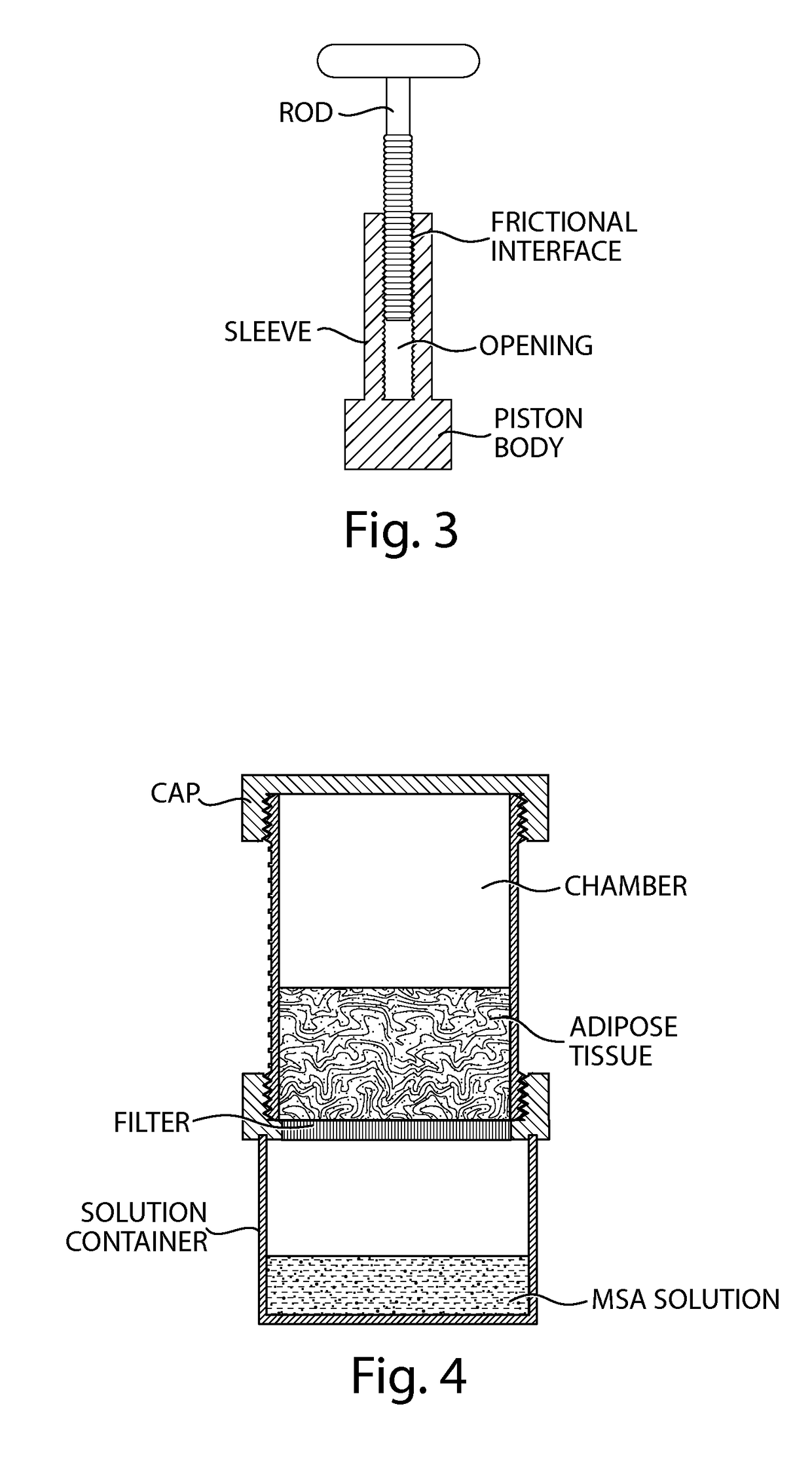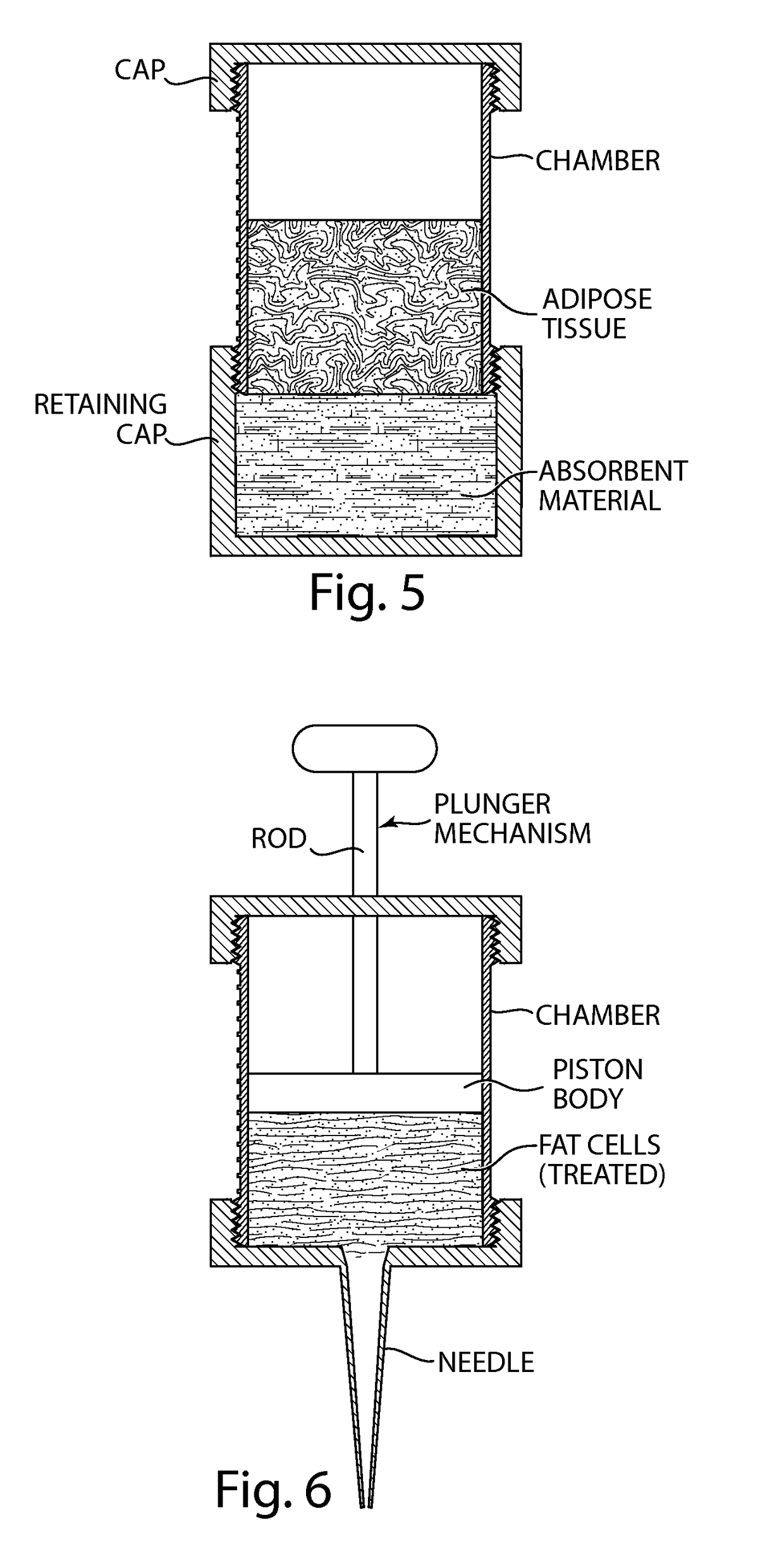System and apparatus for cell treatment
a cell treatment and system technology, applied in the field of system and apparatus for cell treatment, can solve the problems of tissue or cell damage, reduced viability, and relatively high flow rate, and achieve the effect of improving the viability of the gra
- Summary
- Abstract
- Description
- Claims
- Application Information
AI Technical Summary
Benefits of technology
Problems solved by technology
Method used
Image
Examples
example 1
tus for Collecting a Biological Sample, e.g., Adipose Tissue, for Subsequent Re-Use
[0111]FIG. 1 depicts an apparatus for collecting a biological sample, e.g., adipose tissue, for subsequent re-use. The apparatus includes a chamber that is cylindrical in shape. The chamber is provided with a threaded section. However, other coupling arrangements may be used at either or both ends. Other coupling arrangements that may be used include, e.g., pressure-fit connectors, clamps, or the like. O-rings or other sealing arrangements can also be provided to form a leakproof and / or pressure-resistant seal between each chamber end and an end-piece that is configured to be removably attached thereto. Optionally, such end-pieces may be permanently affixed to an end of the chamber and / or configured to be affixed to other end-pieces. The chamber may optionally include volumetric markings to indicate the amount of material contained therein, as shown in FIG. 1. In this example, adipose cells (adipocyte...
example 2
Apparatus with a Hand-Operated Plunger Arrangement
[0112]In another example, a filter, as shown in FIG. 2, can be affixed to the distal end of the chamber depicted in FIG. 1. For example, the collection cap as shown in FIG. 1, if used, is removed, and a plunger mechanism is affixed to the proximal end of the chamber. The chamber is then inverted, such that the distal end of the chamber is on top, and the filter arrangement is affixed to the distal end of the chamber. In certain embodiments, a waste cup is affixed to the chamber, as shown in FIG. 2, or the filter arrangement and waste cup are provided as a single component. An end-piece that includes a hand-operated plunger mechanism is affixed to the proximal end of the chamber.
example 3
Arrangement with a Frictional Interface
[0113]An exemplary force-limiting plunger arrangement that may be used with certain embodiments of the present invention is shown in FIG. 3. This plunger arrangement includes a rod configured to fit into an opening that extends at least partially along a longitudinal axis of a sleeve. A piston body is affixed to a distal end of the sleeve, or it may be formed as an integral part of the sleeve. The rod and sleeve may have circular cross-section shapes, or other cross-sectional shapes may be used (e.g., hexagonal, octagonal, square, or triangular shapes).
[0114]A clutch arrangement, e.g., a frictional interface or the like, can be provided between the outer surface of the rod and the inner surface in the sleeve when the rod is inserted partially into the sleeve, as shown in FIG. 3. In operation, pushing down on the rod with a relatively small force will allow the rod to frictionally grip the surrounding portion of the sleeve and transmit the force...
PUM
| Property | Measurement | Unit |
|---|---|---|
| pressure | aaaaa | aaaaa |
| velocity | aaaaa | aaaaa |
| flow rate | aaaaa | aaaaa |
Abstract
Description
Claims
Application Information
 Login to View More
Login to View More - R&D
- Intellectual Property
- Life Sciences
- Materials
- Tech Scout
- Unparalleled Data Quality
- Higher Quality Content
- 60% Fewer Hallucinations
Browse by: Latest US Patents, China's latest patents, Technical Efficacy Thesaurus, Application Domain, Technology Topic, Popular Technical Reports.
© 2025 PatSnap. All rights reserved.Legal|Privacy policy|Modern Slavery Act Transparency Statement|Sitemap|About US| Contact US: help@patsnap.com



